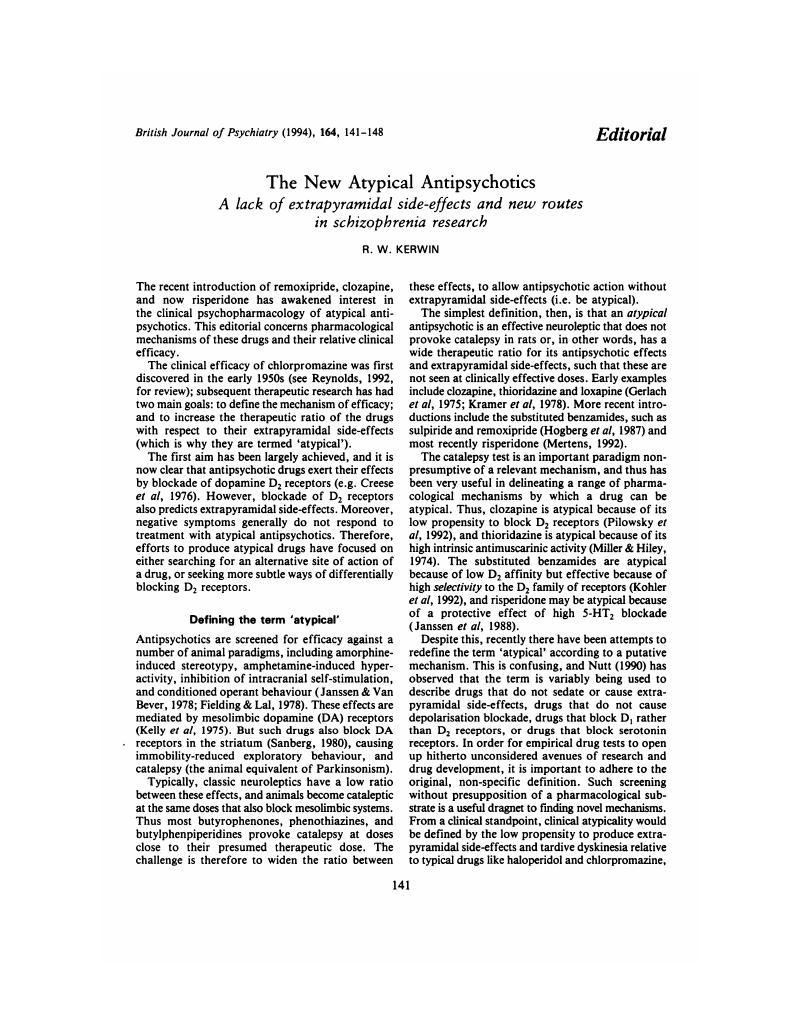Crossref Citations
This article has been cited by the following publications. This list is generated based on data provided by Crossref.
Kane, John M.
and
Freeman, Hugh L.
1994.
Towards More Effective Antipsychotic Treatment.
British Journal of Psychiatry,
Vol. 165,
Issue. S25,
p.
22.
1995.
The drug treatment of patients with schizophrenia.
Drug and Therapeutics Bulletin,
Vol. 33,
Issue. 11,
p.
81.
Arranz, MJ
Dawson, E
Shaikh, S
Sham, P
Sharma, T
Aitchison, K
Crocq, MA
Gill, M
Kerwin, R
and
Collier, DA
1995.
Cytochrome P4502D6 genotype does not determine response to clozapine..
British Journal of Clinical Pharmacology,
Vol. 39,
Issue. 4,
p.
417.
Sajatovic, Martha
and
Ramirez, Luis
1995.
Clozapine Therapy in Patients with Neurologic Illness.
The International Journal of Psychiatry in Medicine,
Vol. 25,
Issue. 4,
p.
331.
Rowlands, P.
1995.
Schizophrenia and sexuality.
Sexual and Marital Therapy,
Vol. 10,
Issue. 1,
p.
47.
WOLFSON, PAUL MARTIN
and
PATON, CAROL
1996.
Clozapine audit: What do patients and relatives think?.
Journal of Mental Health,
Vol. 5,
Issue. 3,
p.
267.
Weiner, Ina
Shadach, Eran
Tarrasch, Ricardo
Kidron, Rachel
and
Feldon, Joram
1996.
The latent inhibition model of schizophrenia: Further validation using the atypical neuroleptic, clozapine.
Biological Psychiatry,
Vol. 40,
Issue. 9,
p.
834.
Pilowsky, L. S.
Busatto, G. F.
Taylor, M.
Sharma, T.
Sigmundsson, T.
Costa, D. C.
Ell, P. J.
and
Nohria, V.
1996.
Dopamine D2 receptor occupancy in vivo by the novel atypical antipsychotic olanzapine — a123 IBZM single photon emission tomography (SPET) study.
Psychopharmacology,
Vol. 124,
Issue. 1-2,
p.
148.
Ring, Howard
1996.
Serotonin central synaptic transmission and the regulation of the extrapyramidal system: the psychiatric perspective.
Human Psychopharmacology: Clinical and Experimental,
Vol. 11,
Issue. S2,
p.
S83.
Small, Joyce G.
Milstein, Victor
Malloy, Frederick W.
and
Miller, Marvin J.
1996.
Quantitative electroencephalographic frequencies and relative neuroleptic receptor affinities in schizophrenia.
Biological Psychiatry,
Vol. 39,
Issue. 11,
p.
986.
Naylor, L.
Dean, B.
Opeskin, K.
Pavey, G.
Hill, C.
Keks, N.
and
Copolov, D.
1996.
Changes in the serotonin transporter in the hippocampus of subjects with schizophrenia identified using [3H]paroxetine.
Journal of Neural Transmission,
Vol. 103,
Issue. 6,
p.
749.
Burnet, P.W.J.
Chen, C.P.L.-H.
McGowan, S.
Franklin, M.
and
Harrison, P.J.
1996.
The effects of clozapine and haloperidol on serotonin-1A, -2A and -2C receptor gene expression and serotonin metabolism in the rat forebrain.
Neuroscience,
Vol. 73,
Issue. 2,
p.
531.
Sundram, Suresh
Dean, Brian
and
Copolov, David L.
1996.
Typical and atypical neuroleptic drugs decrease platelet 3H-dopamine uptake in the rat.
Psychiatry Research,
Vol. 62,
Issue. 3,
p.
259.
Bart Vrtunski, P.
Eric Konicki, P.
Young Kwon, K.
Jaskiw, George J.
and
Jaskiw, George E.
1996.
Effect of clozapine on motor function in schizophrenic patients.
Schizophrenia Research,
Vol. 20,
Issue. 1-2,
p.
187.
Lader, M.
1996.
Implications of Psychopharmacology to Psychiatry.
p.
127.
Pantelis, Christos
and
Barnes, Thomas R.E.
1996.
Drug Strategies and Treatment-Resistant Schizophrenia.
Australian & New Zealand Journal of Psychiatry,
Vol. 30,
Issue. 1,
p.
20.
Barnes, Thomas R.E.
and
Kane, John M.
1996.
Choosing between old and new antipsychotics.
Current Opinion in Psychiatry,
Vol. 9,
Issue. 1,
p.
41.
Ramsay, Rosalind
and
Fahy, Tom
1996.
Mental Health Matters: A Reader.
p.
290.
Sanyal, Suparna
and
Van Tol, Hubert H.M.
1997.
Review the role of dopamine D4 receptors in schizophrenia and antipsychotic action.
Journal of Psychiatric Research,
Vol. 31,
Issue. 2,
p.
219.
Soares, Jair C.
and
Gershon, Samuel
1997.
Therapeutic targets in late-life psychoses: review of concepts and critical issues.
Schizophrenia Research,
Vol. 27,
Issue. 2-3,
p.
227.




eLetters
No eLetters have been published for this article.